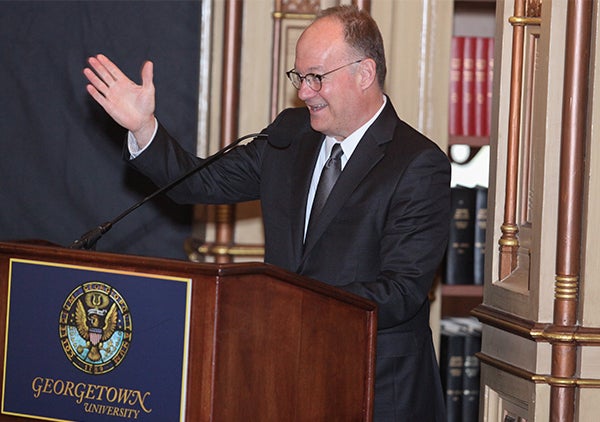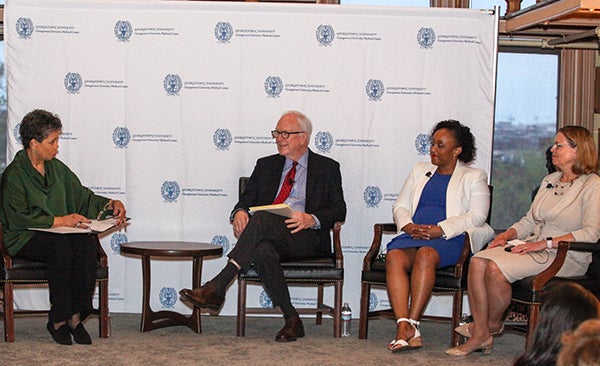Georgetown Women in Medicine Celebrates 25 Years

Posted in GUMC Stories | Tagged Georgetown Women in Medicine, School of Medicine, women in STEM
(April 12, 2019) — With the much-anticipated unveiling of a new portrait as part of the Women on the Walls campaign to honor women leaders at the Georgetown University Medical Center, Georgetown Women In Medicine (GWIM) celebrated its 25th anniversary alongside more than a hundred faculty, students, staff and supporters.

The April 11 evening event at the historic Riggs Library in Healy Hall honored the organization’s legacy and provided an opportunity to discuss the future for women in medicine.
John J. DeGioia, president of Georgetown University, spoke of GWIM’s accomplishments, remarking on how the group’s work has positively affected the wider university community.
“We wish to express our deep gratitude for GWIM’s work to promote equity over the past quarter century. This work continues to influence and inspire our university community as we look ahead to the ways in which we carry these efforts forward toward ever greater gender equity. We celebrate those whose example, advocacy and commitment to our community has brought us to this moment.”
Pursuing Professional Advancement at the Medical Center
GWIM was first established as a task force in 1994 by John Eisenberg, MD, then chair of the department of medicine. The name was changed to Georgetown Women in Medicine in 2005 and the mission has stayed consistent: to promote the professional advancement of women faculty at Georgetown University Medical Center.
“We all work together for a common goal: to promote career advancement of women faculty actively at Georgetown and to have an environment that will further establish equality in compensation, visibility and leadership,” said Nady Golestaneh, PhD, MSc, president of GWIM and assistant professor of ophthalmology, neurology, biochemistry and molecular & cellular biology.
The organization has three priority areas: visibility, leadership and compensation equity. These three areas guide GWIM’s measurable goals, several of which have come to fruition.
In 2015, under the leadership of former GWIM president Stacey Kaltman, PhD, GWIM reached one of their biggest milestones — to have 100 current women professors at GUMC. Moreover, they have recently announced that they hope to have at least 25 percent women chairs by 2025.
“We have very talented women at Georgetown, accomplished women, who are deserving of leadership positions. We want to have a fair and transparent selection each time,” said Golestaneh.
Increasing the Visibility of Women at Georgetown
Visibility, one of GWIM’s pillars, was the focus of the 25th Anniversary event with the unveiling of the portrait of Estelle Ramey, PhD, painted by award-winning portrait artist Gavin Glakas.
Ramey, an endocrinologist and physiologist, is famously known for using her medical training to disprove allegations that women’s hormones make them unfit to hold office. She was also the founder and onetime president of the Association for Women in Science and a former member of the President’s Advisory Committee for Women.

“The selection of Dr. Ramey is a great choice. She was a wonderful scientist, a great mentor, strong and visible advocate for women’s rights and, very happily for us, a member of the Georgetown family for many years,” said Edward B. Healton, MD, MPH, executive vice president of health sciences and executive dean of the School of Medicine.
Some of Ramey’s family members, including her children Drucilla Ramey, JD, and James Ramey, MD, as well as her grandchildren, Sarah, Meg, Jim and Jessica Stender, were present at the event.
Drucilla and James Ramey shared several stories about their mother, Estelle Ramey. In one example, they recounted how their mother would always encourage her laboratory assistants to apply to graduate school. She even helped a few of them pay for it.
“She felt kindness was important,” said Drucilla Ramey. “If you’re lucky enough to be in a position of power, any position of influence, you should use it to extend kindness to others.”
The Next 25 Years: The Future for Women in Medicine
Before beginning a panel discussion on the future for women in medicine, award-winning broadcast journalist, Maureen Bunyan, Ed.M., shared sobering statistics.
According to the Harvard Business Review, more women than men were enrolled in medical schools in the U.S. in 2018. However, women make up only 34 percent of physicians overall. The numbers decrease further when accounting for women in medical leadership positions, with 18 percent as hospital CEOs and 16 percent as academic deans and department chairs.

Armed with this information, panelists Michelle Roett, MD, MPH, chair of the department of family medicine, Shawna Willey, MD, chief of the department of surgery, and Healton discussed the challenges women face on the path to leadership positions.
“Finding sponsors is key,” said Roett. “Early in my career, having sponsors and mentors helped me see that the door is always open. I constantly asked to have conversations about my leadership path, and that helped.”
The conversation focused on productive ways that women in medicine could pave the way for career advancement, such as mentorship, sponsorship and the creation of pipeline programs. Healton also shared the ways in which the medical center is working with GWIM to ensure gender equity remains priority.
“We’ve begun to focus on issues like implicit bias, especially in regard to recruitment and leadership advancement. We want to make sure there’s adequate mentoring and that we’re emphasizing self-advocacy,” he said.
When asked about the future for women in medicine 25 years from now, the panelists were optimistic.
“I think we’ll have more equality in the numbers of women in medicine,” said Willey. “Women struggle with feeling like we have to choose between a career and children. We don’t want women to have to make that decision. We just need to do it, to ascend to leadership positions, and figure it out.”
Roett would like to see more women and minority physicians in leadership roles. “I would love to see more numbers, more women being celebrated and more programs that have a pipeline to help women see themselves in these roles,” she said.
Healton hopes that, in the future, the conversation will have changed entirely. “In 25 years, I hope that we’re talking about maintaining equity and not achieving it. It’s incumbent upon leaders to make sure that concerns are no longer concerns — leadership in particular. GWIM is a role model for leadership.”
Giuliana Cortese
GUMC Communications
